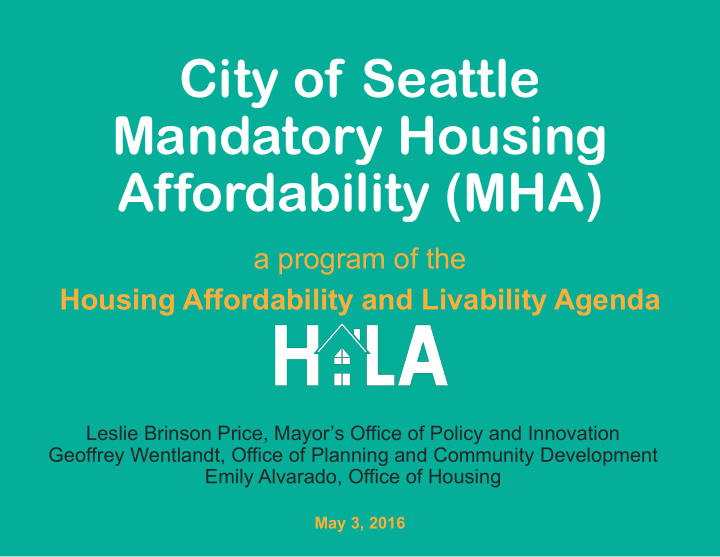



City of Seattle Mandatory Housing Affordability (MHA) a program of the Housing Affordability and Livability Agenda Leslie Brinson Price, Mayor’s Office of Policy and Innovation Geoffrey Wentlandt, Office of Planning and Community Development Emily Alvarado, Office of Housing May 3, 2016
Housing Affordability and Livability Agenda 50,000 housing units over the next 10 years 30,000 20,000 market-rate homes built affordable homes created • Continue growth in • Net new rent/income urban centers and restricted units (about 3 times villages current production) • Reduce permitting • Funding programs barriers • ≤ 60% AMI (generally) • Equitable development in • Maximize efficient new and existing buildings construction methods • Reduce disparities: housing • Critically needed supply for broad demographics to meet existing demand (families with children; shortages seniors; race/ethnicity) • Incentive programs • 60% to 80% AMI (generally) • Affordability in market-rate development
Housing Affordability and Livability Agenda 20,000 affordable homes over the next 10 years MHA-Residential 3,700 affordable homes MHA-Commercial Other HALA Strategies 2,400 affordable homes 13,900 affordable homes • Seattle Housing Levy • Multifamily Tax Exemption • Preservation Tax Exemption • Increased state resources • Increasing federal resources
What is MHA? Mandatory Housing Affordability: A new program to create affordable housing as we grow • Requires that new multifamily residential and commercial development contribute to affordable housing • Provides additional development capacity to offset or partially offset the cost of these requirements
Council Resolution 31612 adopted November 2015 • Reflects principles of Grand Bargain agreement to: • Implement a Mandatory Housing Affordability (MHA) program for new commercial and multifamily development • Set requirements based on a commitment to produce 6,000 units at 60% AMI through both programs • Increase development's contribution to affordable housing • Tie new mandatory affordability contribution to increases in development capacity • Create a stable and predictable program • Commits to inclusive public outreach and engagement MHA - Commercial Ordinance MHA - Residential Ordinance (Affordable Housing Impact Mitigation) Transmitted May 3, 2016 Fall 2015 Zoning changes to activate both programs – 2016 - 2017
How will MHA impact affordability? Single Person Household $3,500 $3,000 $2,500 $1,838 = average rent 1B / 1B – newly constructed units $2,000 $1,528 = average rent 1B / 1B – all units $1,500 $1,009 = rent of 1B / 1B under MHA $1,000 $500 $0 Sources: Dupre+Scott Apartment Advisors, Apartment Vacancy Report, 20+ unit buildings, Fall 2015, Seattle-14 market areas; WA Employment Security Department, Occupational Employment & Wage Estimates, Seattle-Bellevue-Everett, WA MD, 2014.
Mandatory Affordability Requirements Citywide EXISTING PROPOSED Voluntary Incentive Zoning for Mandatory Housing Affordability (MHA) affordable housing (IZ) Applies in all Applies in certain commercial and zones in Downtown, multifamily zones South Lake Union, where development and a few other capacity is neighborhoods where increased. development capacity above base limits is available. Proposed Existing Mandatory Housing Voluntary Incentive Affordability area Zoning area Potential Manufacturing & Urban Village Industrial Center Expansion area
MHA-R Program Details Enabling legislation to create program • Does not yet include payments or performance requirements, added at time of increased development capacity. Applies when new residential units are built or created • Dwelling units, live/work units, or congregate sleeping rooms, but not ADU/DADU • No minimum threshold • Does not apply to subsidized affordable housing projects Payment and Performance • Payments calibrated relative to performance • Performance units will serve: • Rental: Households ≤ 60% AMI (40% AMI for units < 400 sq ft) • Homeownership: Households ≤ 80% • Payments strategically invested in across the city to • Address needs of communities vulnerable to displacement • Promote fair housing choice and economic opportunity • Support broader City strategies to promote growth near transit and within urban centers and villages Increases in development capacity required to activate program
Neighborhood Residential Example
Downtown Residential Example Today (Voluntary IZ) Proposed (Option 1) Proposed (Option 2) • 527 housing units • 565 housing units • 575 housing units • $3.0M in affordable housing • $3.9M in payments (49 units) • $4.0M in payments (50 units) payments (37 units) • 501,000 square feet • 510,000 square feet • 467,000 square feet
HALA Community Engagement Plan January 2016 April 2016 July 2016 September 2016 Dec / Jan 2017 Community Focus Groups (meeting monthly through 2016) Meetings where people already gather (multiple per month) Citywide Conversations Launch Citywide Livability Night Citywide Livability Night Conversation #3 Conversation #4 HALA Conversation #5 Engagement Out Conversation #3 Engagem ent Citywide Citywide Launch HALA Seattle at Out Work
HALA Community Focus Groups Medium Density Urban Villages Expansion Area Urban Villages 12th Ave (Urban Village boundary expansions 23rd & Union–Jackson proposed in Seattle 2035) Admiral Aurora–Licton Springs 130th & I-5 (new Urban Village Bitter Lake proposed in Seattle 2035) Eastlake Columbia City Fremont Crown Hill North Rainier Green Lake / Roosevelt Uptown North Beacon Hill Othello Rainier Beach Lower Density Urban Villages Greenwood–Phinney Ridge HUB Urban Villages Madison–Miller Ballard Morgan Junction Capitol Hill / Pike Pine Ravenna First Hill South Park Lake City Upper Queen Anne Northgate Wallingford University District Westwood–Highland Park West Seattle Junction Outside Area / At-Large Downtown / South Lake Union Manufacturing & Industrial Center
Going to Communities “Arts in the City” Event SouthCORE Community Gathering
MHA Legislative Timeline MHA-R Legislation – Spring/Summer 2016 • Tuesday, May 3 - PLUZ Committee briefing • Tuesday, June 7 - PLUZ Committee briefing • Tuesday, June 21 - Public Hearing • Friday, July 8 - PLUZ Committee discussion • Tuesday, July 19 - Possible PLUZ committee vote • Monday, July 25 - Possible Full Council vote DT/SLU Legislation – Summer 2016 SEPA Comment Period expected May 31 st – June 21st • • Transmitted to Council in late June Incentive Zoning (IZ) & MHA-C Cleanup Legislation • Transmitted to Council in late June in parallel with Downtown / South Lake Union U District Area Rezone 23 rd Ave Area Rezone Zone-wide Changes to other areas – Summer/Fall 2017
Recommend
More recommend